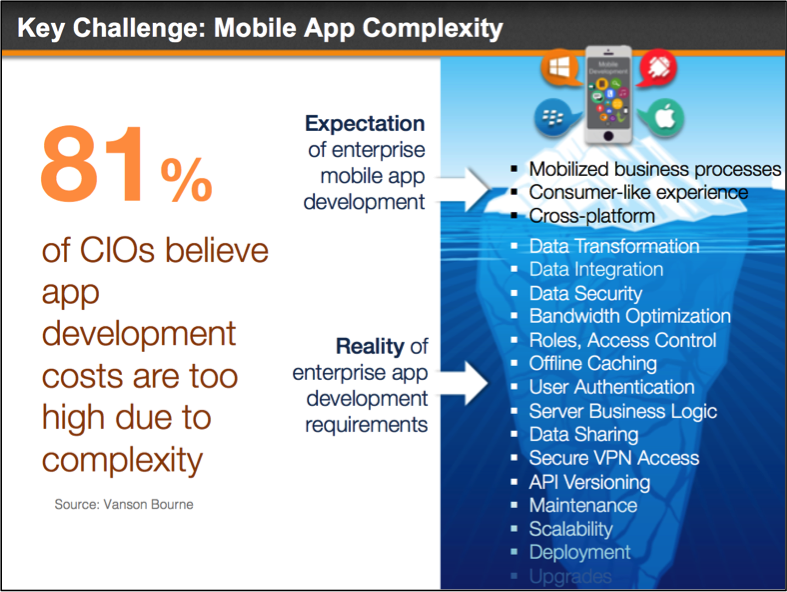Each year Gartner predicts the future on several coverage areas. Naturally, with mobile being one of Gartner’s “Nexus of Forces”, mobile apps and development was an area of focus for one of these reports. They recently published their mobile apps and mobile app development predictions for 2016 (Gartner subscription required to read the full report).
What makes Gartner’s report interesting is that they provide a set of strategic planning assumptions that include a timeframe, a probability, and a statement. You can read more about these in Richard Marshall’s LinkedIn post. It was interesting to see their insights mirror our own experience fairly closely.
Much of the findings speak to the need for modern infrastructure driven by the demand for mobile app development, and more broadly, the digital transformation that many organizations are currently going through. At AnyPresence, we are 100 percent focused on building an infrastructure platform that helps companies take enterprise apps to market faster, at a lower total cost of ownership and with flexibility to evolve without platform lock-in. Given our experience in the space, we thought it would be interesting to review each of Gartner’s strategic planning assumptions in a series of blog posts to provide our perspective and explain how solutions like AnyPresence can play a role.
Gartner Strategic Planning Assumption #1: Through 2018, 40% of application leaders will spend more preparing for mobile app development than they will deliver actual mobile apps.
AnyPresence Take: We think the percent that will spend more time preparing than building could be even higher if leaders are slow to adopt a sensible platform-based approach. Granted, it is self-serving to say so, but there is also enough evidence at this point to make the case for a platform self-evident.
In our experience, the number of custom applications in use across the average enterprise vastly outnumbers off the shelf solutions. In an average large size enterprise, there are potentially thousands of custom-built Windows and Java applications, Access DB forms, Lotus Notes screens, and even macro-laden Excel spreadsheets in various states of usage. If even a small percentage of these applications have to be mobile-enabled, we are talking about several hundred apps that need to be developed over time. One of our customers has a roadmap of 40 to 50 employee-facing mobile apps within the next 24-36 months.
When IT organizations look at what it really takes to transition employee or consumer facing solutions to mobile apps, the task can look daunting for even the most competent app developer team. Each application can have a development lifecycle of six months or longer for complete integration and testing, and we have seen cost estimates of $100,000 or more, just for the first version. Below is an image we developed showing the expectation versus reality of requirements needed when developing enterprise mobile applications.

Against this backdrop, CIOs or IT organizations are understandably concerned about the infrastructure aspects required to efficiently and effective scale mobile app development. This confusion and fear often manifests itself in long-term strategic consulting engagements, mobility maturity assessments, the formation of mobile competency centers, and various other preparatory tasks, which, while well-intentioned, often delay or defer the actual development of mobile apps for months or even years.
Considerations:
Most IT application leaders in an organization will probably agree that traditional development approaches and overly cumbersome methodologies are probably not the right approach to modern, agile app development. Therefore, the same principles of a faster-paced, agile, and less risk-averse approach need to be applied to the preparation phase of mobile app development. Just do it.
The good news for IT organizations is that there are now many market-proven, road-tested platforms, frameworks, and development tools to help establish this infrastructure quickly. By implementing backend services platform solutions like AnyPresence, enterprises can dramatically reduce the amount of time it takes to deploy modern enterprise application infrastructure, which ultimately helps lower the cost and risk of iterative app development, so organizations can get started quickly and learn by trying, rather than falling into a less productive cycle of over-preparation.
For more information on how to avoid falling into the 40% of application leaders that will spend more preparing for mobile app development than they will deliver actual mobile apps, we recommend the following reading:
- Digital Business Platform Best Practices
- Top 10 Characteristics of Enterprise Backend Services
- Time and Cost Savings Calculator for using a Backend Servies Platform
By 2020, 70% of enterprise mobile apps used in enterprises will be developed or adopted without IT involvement.